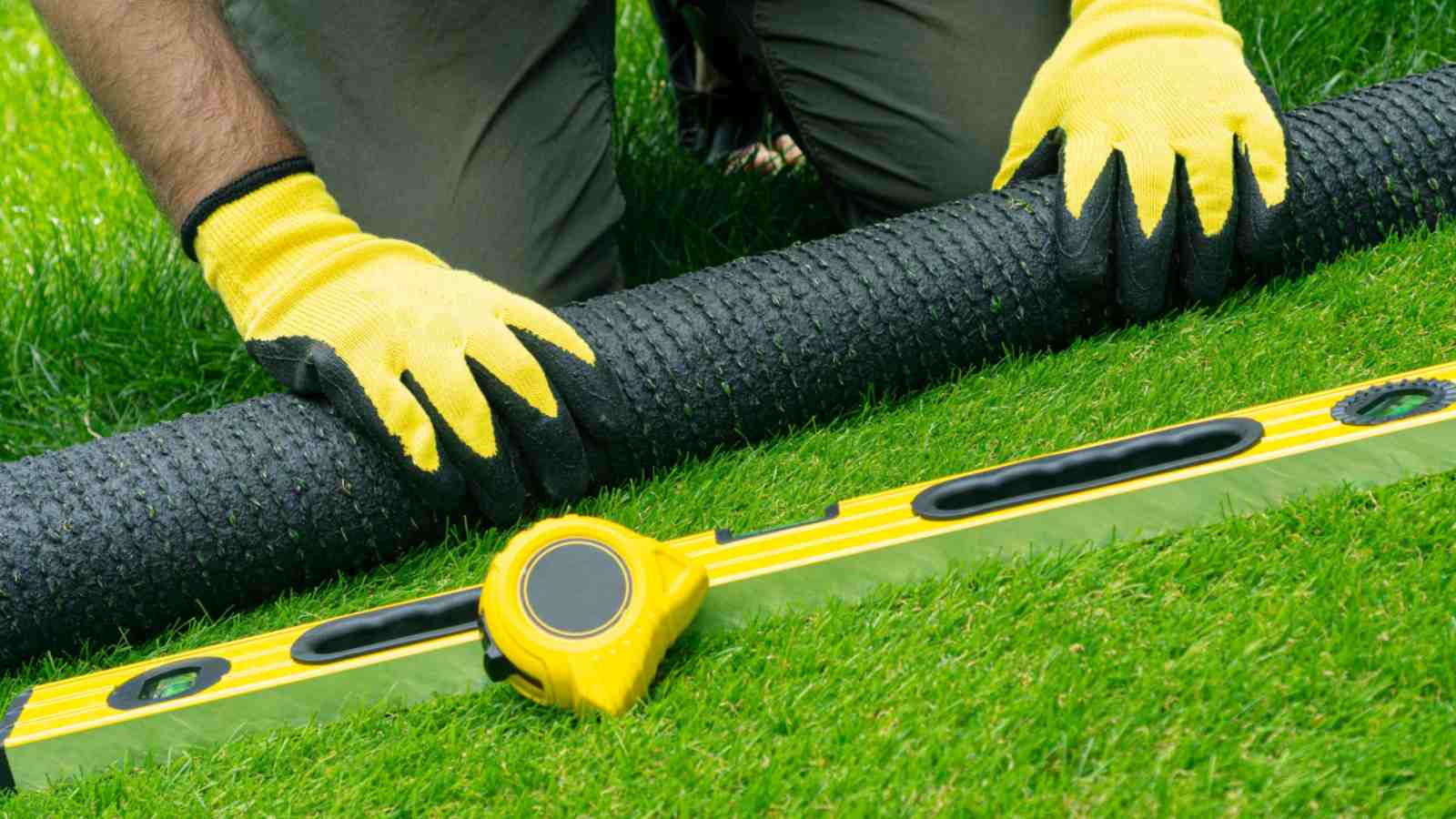Tutorial on Garden Levelling
What kind of garden do you have? If so, you may want to consider levelling your garden to avoid future issues with water accumulation, drainage, and more.

Look at our detailed instructions on how to level a garden to be sure you do it right.
The reason why your garden needs to be levelled
Multiple things could be making your garden uneven:
- The grass could be damaged if children trampled on the soft soil while playing.
- Animals who wander your garden and dig it up.
- If you have pipes or rocks under your garden, it can change the way your lawn grows.
- Wet spots can form in your yard during the winter. This can be a major cause of bumps and lumps. You need to make sure your drainage is right.
Before you can learn to level a garden, you’ll need to determine why the soil in your garden is uneven.
Maybe the incline in your garden has gotten old, and the patchy grass is making it difficult to enjoy your garden to its fullest potential.
You should spend time levelling your lawn if you’ve noticed any of the above problems in your landscape. Don’t fret; assistance is on the way! In this piece, we’ll provide you with the resources and knowledge to properly level a garden.
Landscape Levelling
There are several reasons why you would want to level your garden, including practical ones and the desire to give your outdoor space a facelift.
Before you do any of the following in your garden, please remember to level the soil.
- Patio design
- Setting up the deck
- Laying down artificial grass
- Laying down new turf
Here is a simple, 9-step plan for levelling a lawn:
Step 1 – Inspection
Prior to using any equipment or supplies in your garden, you must first do a thorough check.
The first step in bringing your garden to a uniform level is to measure the depth of the existing holes and bumps. There are two distinct kinds of locations to keep an eye out for:

First, identify any shallow bumps and any deep areas (those deeper than 2 centimetres).
The strategy employed to restore your lawn’s levelness will depend on the degree of the damage. In the succeeding sections, we will go deeply into each of these topics.
The second step is to use a wooden board to determine the slope and level of your grass. You can use the board to determine the lawn’s slope by setting it flat on the ground.
Step 2 – Measuring Slope
Using a wooden board is the most straightforward method for determining the lawn’s level and slope. You should be able to identify the lawn’s slope by placing the board on the ground.

Set a wooden post or peg into the garden’s upper slope, then set a second stake at the garden’s far end.
Make sure the string is level as you tie it from one stake to another. Using this, you can determine the exact height of your lawn.
Step 3 – Remove previous turf
You’ll want a squared-off shovel for regions that are a little deeper and sunken. With the shovel, you can smooth over the bumps in the ground.

Step 4 – Removing debris
Place the shovel in the middle of your bump and make a cross-shaped cut in the ground. This will help you move the grass and dirt around without making a big mess.

Step 5 – Levelling soil
Then, make a cut about 5 cm deep under the cross section you just made. When you take out the piece of soil, make sure to keep the shovel as steady and flat as possible and keep the soil’s thickness level and even.

Step 6 – Making soil compact
Perform the previous step again, and this time, pull back the turf’s edges as you go. You need to be able to take the dirt away and keep it packed down without it breaking.

Get rid of any extra dirt so that the area stays as level as possible with the rest of it. Put any dirt or grass you want to get rid of in a bucket.
Step 7 – Conditioning the soil
The soil must be corrected. Fork the dirt if you want to accomplish this.

Bring your fork down to a depth of around 6 inches. Applying pressure with the use of your foot. Carefully excavate the turf area, making sure to get rid of any rocks, gravel, or lingering weed roots.
Step 8 – Moisture surface
Assisting the soil in retaining moisture is an important step in enhancing its condition.

Apply a thin layer of fresh compost or farmyard manure to the soil. Add the new compost to the soil and stir it well with a fork.
Step 9 – Pressing the soil
Firming and levelling the soil is the next step after digging over all the dirt to prevent any holes from forming underneath the surface.
Paving a garden is as simple as walking on your heels across the lawn and pressing down on the soil with little steps, using your body weight as pressure. Carry on in the same manner as you went down the lawn. You can check if any air pockets have been removed by doing this.
In an effort to level the surface, pull the rake over it.

To further compact the earth, you’ll have to walk in the opposite direction with your heels. Next, rake it over once again. This process may require multiple iterations.
It’s about time you checked your garden’s level. When maintaining a level lawn, measure the height of your edging strip or walkway and follow it. The rope and wooden stakes you have on hand could also serve as a useful guide.
To ensure a perfectly level surface, set a wooden board on the ground and then use your spirit level to measure its exact location.
Just step away for three or four weeks to let the natural elements do their job of compacting and stabilising the soil.
Leaving the ground for three to four weeks gives you the green light to move on with any additional plans, like constructing a patio or deck.
Garden-Levelling Instruments
In order to get your yard perfectly levelled, you will need the right equipment.
Gardening Equipment

The following can be found at any number of garden centres or ordered online:
- Tools: Rake, fork, and shovel with a straight edge
- Wheelbarrow
- Spirit level
The work of levelling your garden may appear simple at first glance, but it requires the use of some quite hefty tools, which, if handled improperly, could be dangerous and even lead to harm.
Gardening Gloves
To keep your hands safe, you will need to wear these gloves the whole time. If you are going to touch compost or fertiliser, you should also wash your hands.
Safety Shoes
Protect your feet from forks, shovels, and rakes by wearing these sturdy boots. Avoid having any pointed things near your feet. The process of levelling will go more smoothly if you wear footwear.
Supplies for Garden Grading
If you want a perfectly even lawn, you’ll need more than just tools and safety gear; you’ll also need the following supplies:
- Fertiliser
- Compost
- Spectracide Weed and Grass Killer
- Wooden stakes or pegs
- String
Apply weed and grass killer (optional) before proceeding with the detailed instructions. If you have a weed problem in your garden, be sure to use the product as directed. During the smoothing process, the remnants might be removed.
How to Get Your Garden Ready for Levelling
Assessing the area to be levelled is the first step in preparing your lawn.
You should also check for actual or possible pipe damage and drainage issues. In order to proceed, it is recommended that you consult an expert.
If you have drainage problems, you should regrade the lawn and modify the levelling to make it slope away from your house.
A specialist should be consulted before installing an underground drainage system.
Pre-watering your lawn for a few days (three to four) will also help soften the soil and make it more conducive to planting.
You also don’t want to work with soil that’s too wet, so be careful not to overwater your grass during this process.
Please use a weed and grass killer according to the product’s directions if your garden has a weed problem.
Garden Maintenance

Your garden, like everything else, will need care and attention on a regular basis. It’s common knowledge that driving on poorly maintained roads may be frustrating and even dangerous over time.
The same is true for your garden; if you don’t take care, you’ll notice some bumps and hollows in the ground.
Maintaining an even lawn and avoiding unsightly bald spots requires a lawnmower that glides effortlessly over the grass.
Avoid making ruts in your grass with your lawnmower if at all possible. To avoid this, try switching up your lawnmower’s cutting pattern every so often.
Frequently Asked Questions
How much should I budget for a professional lawn-levelling service?
Given the unique layouts and sizes of each garden, it’s tough to provide a precise estimate. Hiring a professional to level your yard can be pricey; in addition to their hourly rate, most contractors will add on the price of a skip, which could range from £150 to £300.
You should be ready to pay the professional on an hourly or daily basis, which might cost as much as £250 per day.
It’s in your best interest to shop around and compare estimates from multiple service providers to discover if there is a price difference.
When should you level your garden for optimal results?
We recommend springtime for levelling your garden.
You get just the appropriate amount of sun and rain, which maintains a healthy moisture balance in your soil. The period is also ideal for planting grass seed.
Is it possible to flatten off a really steep slope in your garden?
If your garden is really steep, one solution is to create multiple levels by constructing a retaining wall. This will help the wall hold up the garden’s soil.
The wall will receive the bulk of the precipitation and relieve the earth of its weight and moisture burden. If there is a problem with water accumulation, this will help. Before constructing the retaining wall on your own, you should consult an expert.
Can you level your garden without getting permission?
This is a common oversight, but before digging in your garden, you should verify with the city hall or utility company to make sure there are no underground wires or pipes.
Avoid damaging any pipes with your excavating. It’s smart to double-check before diving into a new project. If you want to increase your garden’s footprint, you might need to get permission from the local government beforehand.
Can I add topsoil to an already-established lawn?
The answer is yes. Topdressing is the term for this procedure. Two parts sand, two parts topsoil, and one part compost make up the combination.
The soil and drainage will be improved, and any humps and hollows will be filled in with this mixture.









